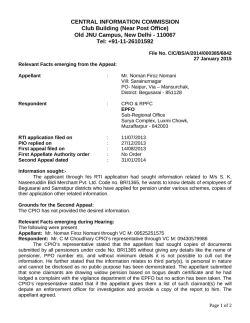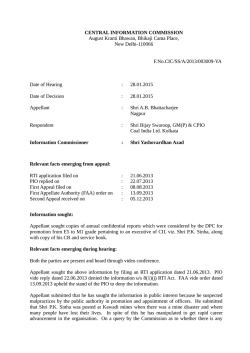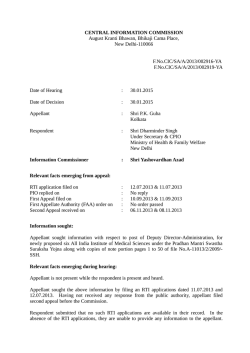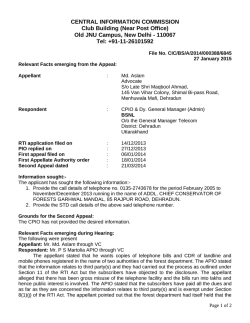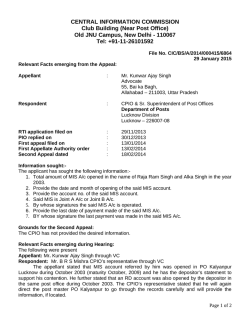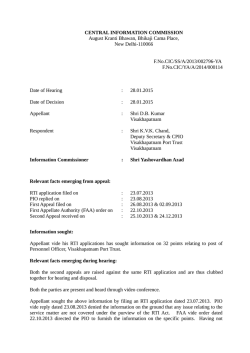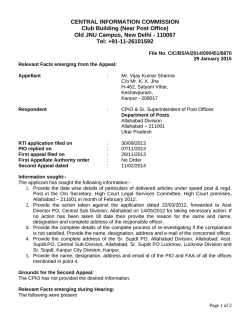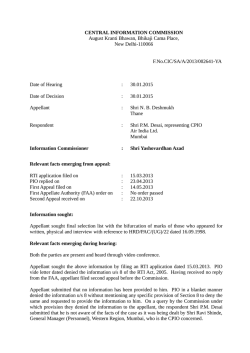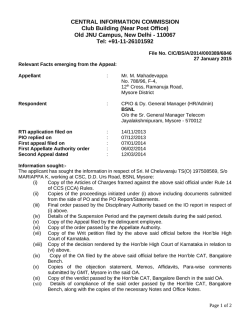
In the Supreme Court of Georgia Decided: February
In the Supreme Court of Georgia Decided: February 2, 2015 S14A1918. THOMAS v. THE STATE. BENHAM, Justice. Appellant Bobby Gene Thomas was convicted, as a party to the crimes, for malice murder and other offenses arising out of a convenience store armed robbery.1 For the reasons set forth below, we affirm the convictions. 1 The crimes occurred on January 14, 2006. A Dougherty County grand jury returned an indictment on July 26, 2007, charging appellant with malice murder (Count 1) and felony murder (aggravated assault) (Count 2) of Herbert Wells; armed robbery (Count 3); aggravated assault of Gary Patel by assaulting him with intent to rob (Count 4); aggravated assault of Gary Patel by shooting him with a deadly weapon (Count 5); aggravated assault of Herbert Wells by shooting him with a deadly weapon (Count 6); aggravated battery of Gary Patel by maliciously causing bodily harm by rendering his leg useless by shooting him in the leg (Count 7); and aggravated battery of Herbert Wells by maliciously causing bodily harm by rendering his brain useless by shooting him in the head (Count 8). Each of these counts charged appellant as a party to the alleged crimes by intentionally aiding and abetting Earl Randolph Scott, who was indicted separately. Appellant was tried by a jury September 17-19, 2007, and the jury found him guilty on all counts. The conviction on the charge of aggravated assault of Wells (Count 6) was merged with the count for felony murder (Count 2), and the conviction on the charge for felony murder was vacated as a matter of law. For sentencing purposes, the trial judge merged the conviction for Count 5 with the conviction for Count 1. The trial judge sentenced appellant as a recidivist to imprisonment for life without the possibility of parole on Count 1; imprisonment for life without parole for Count 3, to be served consecutively with the sentence for Count 1; imprisonment for a term of twenty years without the possibility of parole for the conviction for Count 4, to be served concurrently with the sentence for Count 1; imprisonment for a term of twenty years without the possibility of parole for the conviction for Count 7, to be served concurrently with the sentence for Count 1; and imprisonment for a term of twenty years without the possibility of parole for the sentence for Count 8, to be served consecutively with the sentence for Count 7. Appellant filed a motion for new trial on October 17, 2007, which was later amended, and the motion was heard on November 25, 2013. By order dated April 24, 2014, the trial court denied the motion. Appellant filed a timely notice of appeal on April 29, 2014. 1. We first address appellant’s assertion that insufficient evidence was presented to prove beyond a reasonable doubt that he was a party to the crimes committed by his accomplice, Earl Randolph Scott. Viewing the evidence in a light most favorable to the verdict, the surveillance camera videos at the convenience store that was robbed show appellant, who was identified at trial in these videos by his clothing, entered the store just minutes before a person identified as Scott entered. Both were wearing dark hooded jackets, and on the video appellant is distinguishable from Scott because appellant’s slacks appear to be black and his jacket, while dark, is lighter in color than his slacks, whereas Scott’s jacket and slacks both appear to be black. Another distinguishing characteristic is that Scott’s light-colored shirttail is shown hanging below the bottom of his jacket. The two stood at the lottery ticket desk for several minutes looking around the store. Both of them appeared to be wearing a white glove or carrying a white cloth wrapped around one hand. Scott exited the store and walked to the corner of the building. One of the outside cameras shows a hand that appears to be covered in something white being stuck out of the door for a The case was docketed in this Court to the September 2014 term of court for a decision to be made on the briefs. 2 moment, at which point Scott walked back and re-entered the store. From a contemporaneous video recording taken by an inside camera, appellant was identified as the person apparently signaling at the door. A short time later they both exited the store and walked away, one after the other. Less than half an hour later, Scott drove up to the store parking lot in a two-toned Cadillac and backed into a parking space. A witness who was a lifelong acquaintance of appellant testified that he saw the Cadillac backing into the space, noticed appellant exiting the passenger side of the vehicle, and was able to describe appellant’s clothing. The witness testified that appellant got out of the car first and the driver followed him. From the videotape, the witness identified appellant as the first of the two hooded men to enter the store. After wandering about the store for a few minutes, Scott pulled a gun and can be heard demanding that the clerks open the registers and get down on the floor. Scott then fired two shots. One struck store clerk Gary Patel in the leg. The other struck Herbert Wells, a patron of the store. Wells was transported to the hospital and treated, but he died of his injuries three weeks later. Appellant, in his lighter colored jacket, can be seen in the videotape crouching near the door and looking out. Consistent with the testimony of one of the store clerks, 3 appellant can be heard on the recording exhorting Scott to “hurry, hurry, hurry,” and telling Scott, “Man, come on hurry up, people are coming.” Appellant ran out of the store and out of sight. Scott exited the store, got into the Cadillac, and also left the scene. Apparently, Scott picked appellant up in the car, because shortly after the robbery, Scott drove the Cadillac to a house where Bobby Lee Williams was visiting and asked Williams to drive the car and leave it at a certain hotel. Williams later identified appellant from a photographic line-up as the passenger who exited the vehicle with Scott. The vehicle was found at the hotel and impounded and, pursuant to forensic testing, appellant’s palm print was lifted from the passenger side rear door. The following day, acting on an order to be on the lookout for appellant, an officer went to look for appellant at his girlfriend’s apartment. The officer saw a resident of a nearby apartment pushing appellant out of the apartment as appellant attempted to push his way back in. When appellant saw the officer, he fled through the parking lot, and the officer pursued him and tackled him to the ground, after which appellant was taken into custody. Appellant contends that the only thing the evidence proves with respect 4 to his actions before Scott shot the victims is that he rode to the store in the same car as Scott, got out of the car, and went into the store. Appellant denies the audio portion of the tape establishes that he exhorted Scott to hurry after the shots were fired, and instead argues the tape demonstrates he dropped to the floor as the shots were fired and was just as surprised by Scott’s actions as the others present in the store. The tapes were played to the jury, and it was for the jury to decide whether or not the audio portion of the tapes establish that appellant made the statements the State attributed to him. See Gill v. State, 295 Ga. 705, 707 (1) (763 SE2d 719) (2014) (when reviewing the sufficiency of the evidence, this Court defers to the jury’s assessment of the weight and credibility of the evidence); see also Ferguson v. State, 307 Ga. App. 232 (1) (704 SE2d 470) (2010) (identity is an issue for the jury and it was for the jury to decide whether the videotape of the crime scene showed defendant was the individual who stole a car). Although one of the store clerks testified that a second man, along with the man who shot the victims, was also demanding money and was telling the shooter to hurry up because people were coming, the clerk did not identify appellant or the accomplice at trial. Appellant thus claims there is no direct evidence that he was involved in demanding money and thus insufficient 5 evidence to establish he was a party to the robbery and shootings. Pursuant to OCGA § 16-2-20 (a), “[e]very person concerned in the commission of a crime is a party thereto and may be . . . convicted of commission of the crime.” “[Q]uestions as to the reasonableness of hypotheses other than the guilt of the defendant are generally for the jury to decide, and this Court will not disturb a finding of guilt unless the evidence is insupportable as a matter of law.” Lowe v. State, 295 Ga. 623 (1) (759 SE2d 841) (2014). Mere presence at the scene of the crime and mere approval of a criminal act are insufficient to establish that a defendant was a party to the crime, and “[p]roof that the defendant shares a common criminal intent with the actual perpetrators is necessary.” (Citation and punctuation omitted.) Eckman v. State, 274 Ga. 63, 65 (1) (548 SE2d 310) (2001). But such shared criminal intent “may be inferred from the defendant’s conduct before, during, and after the crime.” Id. See also Slaton v. State, 296 Ga. 122 (1) (765 SE2d 332). Here, there was sufficient evidence of such conduct from which a jury could find that appellant shared a common criminal intent with the perpetrator of these crimes. Thus, pursuant to the standard set forth in Jackson v. Virginia, 443 U.S. 305, 319 (III) (B) (99 SCt 2781, 61 LE2d 560) (1979), the jury was authorized to find beyond a reasonable 6 doubt that appellant was guilty of the crimes for which he was convicted as a party to those crimes. 2. During the State’s voir dire of the prospective jurors, the prosecuting attorney asked the following question: “Is there anyone here who believes that a person who assists another person in the commission of a crime–is there anyone who believes a person who assists another should not be prosecuted?” Appellant’s counsel objected on the ground that the question improperly invoked the ultimate issue, and the trial court overruled the objection and allowed the question. According to appellant, the trial court abused its discretion in permitting this voir dire question to be asked, thereby depriving appellant of a fair trial. He asserts the question posed by the prosecutor suggested he was guilty of assisting in the commission of the crimes involved in the case and thus planted prejudgment in the minds of the jurors. The State, on the other hand, asserts the question was posed to determine whether prejudgment existed in the mind of any prospective juror that appellant should not face prosecution for his conduct. Whether the prosecutor’s question in this case invited prejudgment or simply probed whether any prospective juror already held a fixed opinion about 7 what the result should be, assuming a critical fact in the case, is similar to the issue presented by the appeal of the trial court’s ruling on the proposed jury selection questions in Ellington v. State, 292 Ga. 109 (7) (735 SE2d 736) (2012). In Ellington, this Court reversed the jury’s imposition of the death penalty in a murder trial because we determined the trial court improperly barred defendant’s counsel from questioning prospective jurors about whether they would automatically impose the death penalty in a case involving the murder of young children, which was the subject matter of the action. This Court set forth a detailed analysis of factors to consider with respect to whether a proposed voir dire question is within the proper scope of voir dire examinations. Id. Regarding the scope of voir dire examinations, OCGA § 15-12-133 provides: [T]he counsel for either party shall have the right to inquire of the individual prospective jurors examined touching any matter or thing which would illustrate any interest of the prospective juror in the case, including any opinion as to which party ought to prevail, . . . [or] any fact or circumstance indicating any inclination, leaning, or bias which the prospective juror might have respecting the subject matter of the action . . . . In Ellington, this Court acknowledged that on the one hand, pursuant to this standard, the parties are entitled to ask a prospective juror about whether he or 8 she would impose a certain sentence upon conviction in a criminal trial, or limit the size of an award of damages in a civil trial, based upon certain facts regardless of other facts and circumstances of the case. 292 Ga. at (7) (b) 125126. On the other hand, the parties are not entitled to ask questions that would commit a potential juror to a particular outcome based on speculative proof and hypothetical facts. Id. at 126. But this Court also noted that [t]he line between permissible inquiry into ‘prejudice’ (a juror’s fixed opinion that a certain result should automatically follow from some fact, regardless of other facts or legal instructions) and impermissible questions of ‘pre-judgment’ (speculation about or commitment to the appropriate result based on hypothesized facts) can be hazy. Thus, in this area as in other areas of voir dire practice, appellate courts should give substantial deference to the decisions made by trial judges, who oversee voir dire on a regular basis, are more familiar with the details and nuances of their cases, and can observe the parties’ and the prospective jurors’ demeanor. Id. at 127. See also Sallie v. State, 276 Ga. 506, 510 (3) (578 SE2d 444) (2003). In this case, the question posed by the prosecutor essentially asked whether any prospective juror would automatically conclude that appellant should not be prosecuted if the facts established he merely assisted another person in the commission of the crime. Accordingly, we conclude the question is most reasonably viewed as seeking to determine prejudice in the mind of any 9 prospective juror. We conclude the question did not ask the jurors to prejudge the case based upon hypothetical facts, and we disagree with appellant’s assertion that the question improperly suggested he was guilty of assisting in the commission of the crimes involved in the case or could reasonably be viewed as planting prejudgment in the minds of the jurors. We affirm the trial court’s exercise of discretion in permitting the question posed. 3. The State called Wells’s sister as a witness at trial. She testified that Wells regularly went to the convenience store to sit around and talk to the patrons, that he was disabled, didn’t have a left eye, and had leg problems. She further testified that Wells was “a little slow.” Immediately before trial, during the presentation of pretrial motions, appellant’s trial counsel objected to any potential testimony of this witness about Wells’s mental capability because, appellant argued, an expert witness would be required to present any such testimony. Appellant also objected to any testimony of this witness that would go beyond identifying the victim, such as testimony about his good character, because such evidence would be more prejudicial than probative of any issue related to the victim’s death. The trial court did not respond to the objection asserting that the witness’ testimony would be prejudicial, and the court 10 declined to rule on the objection asserting that the witness would not be qualified to testify regarding the victim’s mental capacity, calling it “premature” until such time as the witness’ testimony might establish her familiarity with the deceased. When the witness testified, appellant’s trial counsel did not renew his previous objections or raise any contemporaneous objection to the witness’ testimony, and he asked no questions of the witness. “Where the trial court reserves ruling on a challenge to the admission of evidence, a defendant’s subsequent failure to object to the testimony when it is admitted or to invoke a ruling by the trial court preserves nothing for appellate review.” Dasher v. State, 285 Ga. 308, 311 (4) (676 SE2d 181) (2009). The issues raised in this enumeration of error were not preserved for appeal. Judgment affirmed. All the Justices concur. 11
© Copyright 2026
